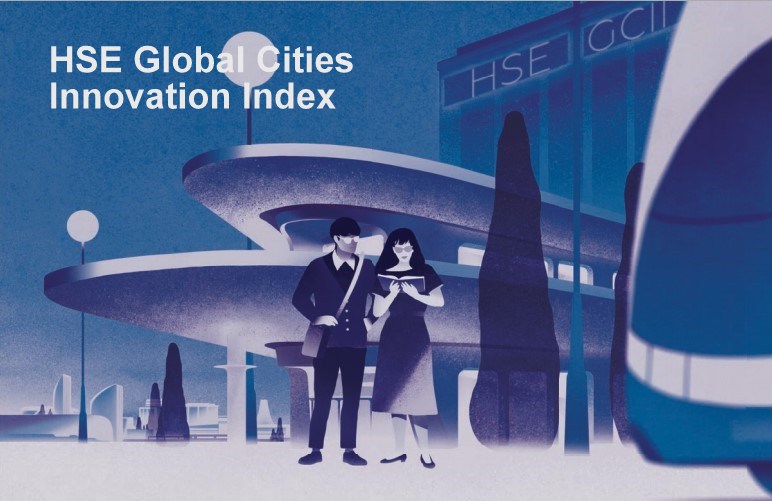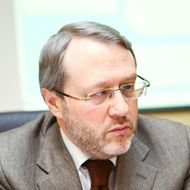HSE University Presents First Global Cities Innovation Index

According to HSE University’s Global Cities Innovation Index, New York and London are the world’s most attractive megacities to innovators implementing creative and technological initiatives. Moscow ranked among the rating’s top ten cities, leading in the areas of ‘Innovation Infrastructure’ and ‘Digital Infrastructure and Services’. HSE researchers presented the index at this year’s Open Innovations Forum.
On October 19, researchers of HSE University made their first public presentation of the HSE Global Cities Innovation Index, which was first developed by the University.
The discussion was held online as part of the Public Talk on 'How Do Metropolises Attract Talent? A Look through the Prism of HSE Global Cities Innovation Index’. Libération journalist Lucien Jacques served as the discussion moderator, and Alexey Fursin, Head of the Department of Entrepreneurship and Innovative Development of the City of Moscow, delivered opening remarks. Mr. Fursin noted the importance of a comprehensive assessment of the factors that promote innovation in cities. Tools such as international ratings, he said, provide an opportunity to navigate already-existing tools and set new trends, as well as provide a source of models upon which other world cities and economies can draw.
Leonid Gokhberg, HSE First Vice Rector and Director of the Institute for Statistical Studies and Economics of Knowledge at HSE University, and the project’s supervisor, Professor Evgeniy Kutsenko, Director of the Russian Cluster Observatory Centre, presented the results of the index. Professor Gokhberg underscored the fact that megacities are the drivers of global development. However, current rankings do not answer the question of what influences representatives of the innovative class — from start-up creators and top managers to artists and designers — in their decision of where to work. The creators of the HSE Global Cities Innovation Index seek to fill this gap.
Leonid Gokhberg, First Vice Rector, Director of the Institute for Statistical Studies and Economics of Knowledge, HSE University

Today we discuss the first results of our new study. We attach utmost importance to the verifiability and transparency of the raw data. Without this, any rating will be controversial and raise doubts among a wide audience. To harmonize approaches to measuring innovation in cities and assessing their innovative attractiveness, we rely on our partnerships with leading foreign researchers, and, first and foremost, our partnership with the friendly team of the Global Innovation Index.
Lorena Rivera León, who was directly involved in preparing the Global Innovation Index and is an economist of the World Intellectual Property Organization (WIPO), further discussed the possibilities presented by the combination of approaches used by the Global Innovation Index and HSE University.
Using a sample of 36 cities that are most attractive to innovators, researchers at HSE University analyzed factors that make the cities attractive and influence their technological development, creative industry, and urban environment. They calculated the index based on 120 indicators. Their analysis showed that the level of creative industry development in a city has a much more significant influence on its potential to attract innovators than its technological potential, infrastructure, or the institutional system.
According to the index, the top ten most innovatively attractive cities are: New York, London, Tokyo, Beijing, Paris, Los Angeles, San Francisco, Moscow, Shanghai, and Seoul. In fact, according to the study, New York and London remain unrivalled: no other cities come close in the race for talent, though all world cities have a comparably high level of service development and life comfort.
The cities in the sample were divided into four structurally similar groups: ‘Talent Attraction Centres’, ‘Alternative Poles of Innovation’, ‘National Leaders with Advanced Infrastructure’, and ‘Specialized Innovation Centers’. Moscow topped the group ‘National Leaders with Advanced Infrastructure’ which included six cities: following Moscow were Shanghai, Seoul, Sao Paulo, Guangzhou, and Mumbai. These are the type of cities that determine the economic development of their countries.
‘The leader of our ranking, by a rather significant margin, is New York. Today this city is the main global magnet for innovators. It has attracted more Nobel and Pulitzer Prize winners than any other city in the world. It also has the largest number of artists, start-ups and traded fashion brands,’ said Evgeny Kutsenko.
As Moscow, an analysis of its ratings indicates visible progress in the field of digital development. The Russian capital ranks eighth in the overall ranking and is the leader in the development of digital infrastructure (wireless Internet, use of open data, car sharing) and infrastructure for innovation support (primarily through the development of technology parks and coworking spaces). The Moscow innovation cluster, which is the largest in the world, brings together more than 12,000 organizations on its digital platform.
The indicators of the study are grouped into 20 sections and divided into three blocks: ‘Technological Development’, ‘Creative Industries’, and ‘Urban Environment’. For each of them a sub-index was calculated that contained city sub-rankings.
All cities that top the integral rating simultaneously show a high level of development in the high-tech and creative sectors. This is the most strategic environment for business as well as startups. This sphere attracts companies from the fashion, film, and art industries, the index creators suggest. As a result, a high level of technological and creative activity develops, and this attracts new entrepreneurs.
Key findings of the study
Talent attracts talent. The presence of global technological innovation leaders and internationally renowned artists lies at the heart of the competition between cities to attract creators of the knowledge economy.
Creativity is the new hallmark of a top city. The level of creative industry development polarizes the global centres of the innovation class more than technological potential, infrastructure, or the institutional system.
Must-haves: mass infrastructure and urban environment. All world cities have a comparably high level of service development and life comfort. Transforming the environment is the first step towards innovative appeal.
Smart city specialization. Of top priority in urban development is not the replication of foreign experience but the conscious choice to pursue one’s own unique path to world leadership, based on an objective understanding of one’s strengths and weaknesses.
The HSE Global Cities Innovation Index is unrivalled in terms of its analytical depth and breadth of indicators. The index can serve as a map for representatives of the innovative class, researchers, members of creative industries, and professionals involved in urban governance and the development of specific sectors of the knowledge economy.
During the discussion, Vyacheslav Shulenin, Deputy Chair of VEB.RF, noted the usefulness of the index, particularly for development institutions. The assessment of the innovative potential of a particular city will greatly influence VEB.RF’s project support decisions, he said. He also stressed that the competition for human capital—for talented people—is one of the most important components in the work of city administrations, and Moscow has made great progress in this.
It seems to me that the next important step should be sharing Moscow’s experience, which has been the most successful in Russia, as well as that of all the global cities of the index, with other cities of Russia
Also participating in the discussion were Ott Vatter, Managing Director of e-Residency Estonia; Burkhard Volbracht, Head of Talent Department at Berlin Partner; Vadim Medvedev, Director of the Department of the Ministry of Science and Higher Education of the Russian Federation; Jani Moliis, Head of International Affairs, City of Helsinki; Vera Futorjanski, CEO and Founder, Veritas Ventures; and Michal Michaeli, Director of International Economic Development at Tel Aviv Global.

